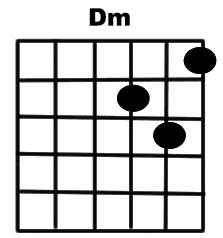D Minor guitar chord

D minor chord is a minor scale based on D, consisting of the pitches D, E, F, G, A, B♭, and C. In the harmonic minor, the C is raised to C♯. Its key signature has one flat (see below: Scales and keys).
Its relative major is F major, and its parallel major is D major. D minor is one of the two flat-signature keys whose melodic and harmonic scale variations require the addition of a written sharp; the other is G minor.
Some consider it the flattest key that is practical for a guitar to play. Of Domenico Scarlatti's 555 keyboard sonatas, which often borrow mannerisms from guitar music of the period, 151 are in minor keys, and D minor is the most often chosen minor key, with 32 sonatas.
J. S. Bach's entire The Art of Fugue is in D minor and, jokingly, so is P. D. Q. Bach's Musical Sacrifice. According to Alfred Einstein, the history of tuning has led D minor to be associated with counterpoint and chromaticism (for example, the chromatic fourth), and cites Mozart's chromatic Fugue in D minor.[1] Mozart's Requiem is also written primarily in D minor. Of the two piano concertos that Mozart wrote in a minor key, one of them is in D minor, No. 20, K. 466. Sibelius's Violin Concerto is in D minor as is Schumann's, although many of the best-known violin concertos are written in D major.
Michael Haydn wrote only one symphony in a minor key, in D minor, Perger 20, MH 393.
Since D minor is the key of Beethoven's Symphony No. 9, Bruckner felt apprehensive about writing his own Ninth Symphony in the same key.[2]
Works in the classical music era and later beginning in minor typically end in major, or at least on a major chord (as picardy third), but there are a few notable examples of works in D minor ending in much sharper keys. Two symphonies that begin in D minor and end in E major are Havergal Brian's Gothic Symphony and Nielsen's Symphony No. 4 (The Inextinguishable). Bruckner's Ninth Symphony, which is often performed without the finale, is another example of a symphony beginning in D minor and ending in E major. Liszt's Dante Symphony opens in D minor and ends in B major.
Similar to a D minor symphony ending in D major, a D major symphony can have for its allegro first movement a slow introduction in D minor. "Tonic minor Adagio introductions, especially in the key of D minor, were very popular with English composers of the year 1794," and Joseph Haydn copied this procedure for the D major symphonies he wrote in London.[3]
The first choice of clarinet for orchestral music in D minor is the clarinet in B♭, and the clarinet part is then written with an E minor key signature. This choice, however, becomes problematic for multi-movement works that begin in D minor and end in D major. The B-flat clarinet parts would be written with an E major key signature, indicating an increased reliance on side keys and thus uncomfortable fingerings. A clarinet in A playing in D major would be written with an F major key signature, but in D minor chord would be written in F minor. One solution is to write the first movement for clarinet in B♭ and the last movement for clarinet in A (this is, for example, what Robert Volkmann does in his Symphony No. 1 in D minor). However, this burdens the player with having to warm up the A instrument in time for the switch. Ralph Vaughan Williams in his Symphony No. 8 in D minor and Dmitri Shostakovich in his Symphony No. 12 simply keep on using clarinets in B♭ even after switching to D major (written in E major). Mily Balakirev, in his Symphony No. 2 in D minor, opts to have three clarinets, two in B♭, one in A, playing throughout the whole piece.
